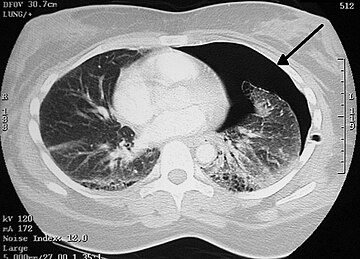Ho sabíeu?
Podeu fer doble clic en una paraula per a buscar-la a TermGallery.
Podeu fer doble clic en una paraula per a buscar-la a TermGallery.
Significats de thoracic injuries en anglès

Sinònims
Examples for "chest trauma"
Examples for "chest trauma"
1
A case of right atrial laceration secondary to closed chest trauma is reported.
2
Two cases of intraabdominal organ injuries due to blunt chest trauma are reported.
3
Flail chest is a rare complication in pediatric patients with blunt chest trauma.
4
Intracardiac shunts are uncommon cardiac lesions caused by blunt chest trauma.
5
Penetrating chest trauma can result in multiple clinical syndromes depending on the structures involved.
1
The mortality rate from cardiac rupture by blunt chest injury is high.
2
NOTES: Texans OLB John Simon left the game due to a chest injury.
3
LB Nate Stupar practiced Wednesday with a chest injury after being limited Tuesday.
4
Cobb, meanwhile, would leave game with a chest injury and he did not return.
5
Methods: Thirteen consecutive patients with severe flail chest injury were enrolled in this pilot study.
1
Rib fractures are the most common thoracic injury after minor blunt trauma.
2
Dismemberment was the main cause of instantaneous death, closely followed by brain injury and heart and thoracic injury.
3
More specifically, the risk of sustaining an AIS2+ thoracic injury was higher in a collision with an MPV.
4
A 3 year old boy sustained blunt thoracic injury and developed respiratory distress, pneumothorax, and subcutaneous emphysema, which were managed conservatively with intercostal tube.
5
Associated thoracic injuries did not influence sternal or spinal treatment outcomes.
Ús de thoracic injuries en anglès
1
Associated thoracic injuries did not influence sternal or spinal treatment outcomes.
2
However, pedestrians sustained twice as many head injuries as thoracic injuries.
3
The management of traumatic thoracic injuries is an area in which thoracoscopic techniques may have significant impact.
4
Emergency services treated the man for thoracic injuries, which the hospital said were "not severe."
5
Background: Injuries of thoracic vertebrae in multiple trauma patients are often accompanied by severe thoracic injuries and sensorimotor deficits.
6
These predictors can be used to create a sensible clinical decision rule for the identification of children with thoracic injuries.
7
The symptoms are variable, and these injuries frequently occur in conjunction with other thoracic injuries, leading to delays in diagnosis.
8
Concomitant injuries occurred with 83% of thoracic injuries and multiple vascular injuries occurred in 25%.
9
However, no test procedure exists for thoracic injuries, which is the body region with the second highest number of severe or fatal injuries.
10
Additional injuries to the head and neck region occurred in 83% of the patients and thoracic injuries occurred in 77% of the patients.
11
Thoracic injuries were primarily blunt rupture or penetrating injury to the thoracic aorta (nine patients).
Aquesta col·locació està formada per:
Translations for thoracic injuries
portuguès

